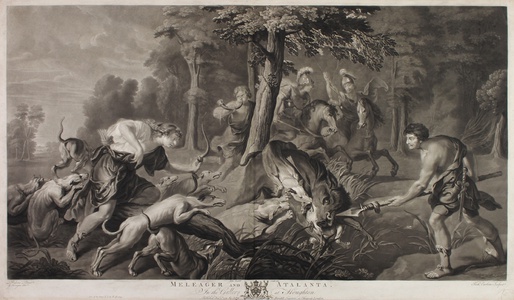| Method | Mezzotint |
| Artist | Richard Earlom after George Farington after Peter Paul Rubens |
| Published | Published Jany. 1st. 1781 by John Boydell, Engraver in Cheapside London. |
| Dimensions | Image 465 x 850 mm, Sheet 514 x 882 mm |
| Notes |
A large scale mezzotint of the Calydonian boar hunt scene from the story of Meleager and Atalanta. The scene shows Meleager to the right, spear in hand, and Atalanta to the left, her bow in hand having hit the boar with her arrow. The boar is at the centre of the scene with several hunting dogs pouncing on it. In the background is the accompanying hunting party on horseback. Meleager, son of the King of Calydon, led a band of heroes to hunt and kill a monstrous boar, that had been terrorising the city of Calydon because of a slight given to the goddess Artemis by Meleager's father Oeneus. Among the heroes was Atalanta, a virgin huntress, whom Meleager immediately fell in love with. After the hunt, Meleager chose to present the boar's hide to Atalanta, as, of all the assembled heroes, she had struck the beast first. An argument ensued because of his decision, and in the scuffle, Meleager defended Atalanta by slaying a number of the other heroes, including his brother and uncle. Upon hearing of the news, Meleager's own mother engineered his death, by burning a brand that the Fates had decreed would end Meleager's life with its final flame. From the 'Houghton Gallery' series (1774-88), 162 prints after paintings in Robert Walpole's collection, sold in 1779 to Catherine the Great. Richard Earlom (1743 - 1822) was a British painter, draughtsman and printmaker. He was born in London, and was apprenticed to Giovanni Battista Cipriani after he was discovered making sketches of the Lord Mayor's coach. This natural faculty for art manifested throughout Earlom's career, and he is believed to have taught himself the technique of mezzotint. In 1765, Earlom went to work for John Boydell, who commissioned the artist to produce a large series of works from Sir Robert Walpole's collection at Houghton Hall. This pair of mezzotints constituted part of this series. His works after van Huysum, as well as the still-life painter Jan van Os, are widely recognised as his most striking. George Farington (1752-1788) was a British history painter and draughtsman. Born in Warrington in 1752, he was the younger brother and pupil of the landscape painter Joseph Farington. He then became a pupil of Benjamin West and entered the Royal Academy Schools in 1770. Farington obtained the silver medal in 1779, and in 1780 won the gold medal for the best historical picture, the subject being 'The Caldron Scene from Macbeth'. For John Boydell, Farington made several drawings from the Houghton collection. In 1782 he worked in India. He fell ill whilst making studies for a grand picture of the court of the Nawab of Murshidabad, and died there a few days later in 1788. Sir Peter Paul Rubens (1577-1640) was an exponent of the Baroque style, and a pre-eminent artist of the seventeenth century. He was a leading painter of altarpieces, history painting, large-scale decorations and landscapes. Born in Germany, Rubens moved to Antwerp in around 1588, where he trained with Otto van Veen. He travelled in Italy between 1600 and 1608, where he was influenced by ancient and Italian Renaissance art. In 1609, he became court painter to Archduke Albert and the Infanta Isabella, Governors of the Netherlands for Spain. From 1628 to 1630, Rubens returned to Spain, where he met Velázquez, then came to England. A scholar, collector and diplomat, he was knighted by Philip IV of Spain and Charles I of England. Wessley 81 Condition: Vertical centre fold as issued. Trimmed within plate mark on lower margin. Repaired tear to bottom right corner. Creasing to top and lower right corners from verso album tabs. |
| Framing | unmounted |
| Price | £650.00 |
| Stock ID | 51303 |

